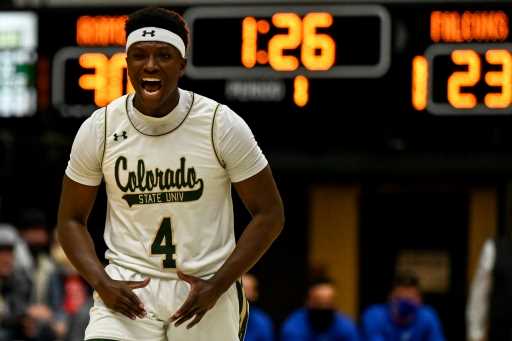FORT COLLINS — Memo to the suits in Indianapolis:
They’re better than this.
Honestly, they are, these CSU Rams. We swear.
Of course, you bluebloods on the NCAA Tournament Selection Committee, you’ll call them excuses.
Doesn’t make ‘em any less real.
No, Rams 67, lowly Air Force 59 doesn’t move the needle. But you’ve also got to consider the backdrop.
Niko Medved’s Rams (11-0, 1-0 Mountain West) were coming off a 24-day layoff.
The Falcons, meanwhile, were coming off a home upset of Utah State on Dec. 29.
The hosts at Moby Arena, no shock, looked as rusty as a ’78 Buick Oldsmobile. CSU misfired on four of its first five shots. They opened 2022, their first January spent ranked among the Associated Press Top 20 since 1954, to a 7-0 deficit in their own building.
And, no we’ll grant you, the Rams can’t have many more evenings like this one against league fare. Not if they want their name called on Selection Sunday. Not if they want to lock down a deserved NCAA Tournament berth in 10 weeks.
The thing about tourney teams, though? Even on their bad nights, it’s the ability to change gears.
The Rams finally shifted up in the final seven minutes of the first half, thanks to an 11-0 run keyed by quick treys by Kendle Moore from the left corner and by Adam Thistlewood off the break. That put the hosts up 27-21 and got Air Force coach Joe Scott barking at any zebra that would listen.
But the ghosts of Pete Carrill and his Princeton offense don’t rest quietly. Air Force’s attack consists of basically two options: A back-door cut or a 3-pointer. And when the latter start falling, it can make for a long night for the longer, more talented teams charged with putting them away.
The Falcons connected on six of their first 13 treys and 10 of their first 21 from beyond the arc. They set the tempo. They turned the evening into a slowed-down game of H-O-R-S-E.
The hosts obliged, whiffing on 16 of their first 28 field-goal attempts, and nine of their first 14 from beyond the arc.
From an aesthetic standpoint, though, it could’ve been worse. Given that the Zoomies went into the evening with a national NET ranking — the NET is the NCAA’s preferred metric for March Madness evaluation — of just 250 out of 358 Division 1 programs, a home loss for CSU would’ve been of the “Quad 4” variety. In layman’s terms, that’s bad. The worst.
Especially as the Rams headed into league play with only one “Quad 1” pelt — as in, a good win against a likely tourney team — on their wall, a 66-63 triumph over Mississippi State on Dec. 11 in Texas that’s become the season’s “signature” victory to date.
COVID wiped out a Dec. 21 semi-road tussle with the Crimson Tide, who ranked No. 20 in the NCAA’s NET rankings and No. 16 by KenPom.com as of early Tuesday evening. It also scratched a tilt against Tulsa, also in Fort Worth, that had been slated for Dec. 18.
“Bama, no shame there,” longtime CBS Sports bracketologist Jerry Palm told me Tuesday night. “(Losing) Tulsa could hurt.”
Because for Medved and the Rams, it’s not so much about the quantity of opponents over the next nine weeks as it is quality.
While their Power 5 brethren get to pad their Big Dance resumes just by beating up on one another, CSU can’t afford similar slips in the Mountain West. The league opened the week ranked No. 8 among Division I circuits by USA Today statnik Jeff Sagarin.
Of the Rams’ remaining 16 league games after Tuesday, only six are slated against opponents currently ranked among the NET’s top 60.
“It’s not a situation where every loss is a huge dent in the resume,” Palm countered. “But they need to avoid the Quad 4 losses entirely and can take a Quad 3 loss. Or maybe two.”
One bullet dodged. Barely. Like the old song goes, survive and advance.
Source: Read Full Article
